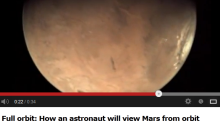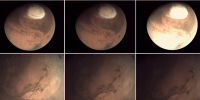Today’s post sent in by Mars Express Spacecraft Operations Engineer Simon Wood, at ESOC. The news? Ten observations slots in the next four weeks, starting today!
You may have noticed that VMC has been very quiet over the last few months.

Mars Express left Earth for Mars on a six-month journey in June 2003, when the positions of the two planets made for the shortest possible route, a condition that occurs once every twenty-six months. Credit: ESA/Medialab
This was due to Mars Express experiencing one of its regular ‘eclipse seasons’. As our orbit precesses around Mars, there are periods during the year during which, for part of the orbit, Mars is between the spacecraft and the Sun. These eclipses can last for up to 40 minutes per orbit with the result that, during this part of the orbit, no power is generated by the solar arrays. This means that your spacecraft is running on battery power only.
This most-recent eclipse season also coincided with aphelion, the point at which we are at our greatest distance from the Sun. This is more pronounced for spacecraft orbiting Mars than for those orbiting Earth, as Mars’ orbit is more elliptical than Earth’s.
Being further from the Sun also means the total solar energy reaching the spacecraft is lower — meaning the total output power of the solar arrays is reduced. The energy from the Sun doesn’t only generate electrical power; as it strikes the body of the spacecraft, it also heats it up.
We have strict temperature requirements for our internal systems and payloads to keep them operating normally; this thermal control is managed by a number of electrical heaters and radiators placed around the the spacecraft. As the overall heat being provided from the Sun is reduced in an eclipse, then the electrical heaters have to work harder and thus draw more power to maintain the required temperature.
The end result of all this is that we have a situation where we have long periods using only the batteries combined with higher power usage by the heaters but less overall power being generated by the solar arrays to recharge the system.
This poses some difficult planning challenges as we have to take steps to reduce overall power consumption and carefully manage the spacecraft subsystems to ensure that we can fully recharge the batteries by the end of each orbit.
In this last season, this has meant doing things like reducing the amount of time the transmitter is on (as this consumes a lot of power) and this has had a knock-on effect on science operations as it means that the overall data volume we can transmit back to Earth is reduced.
The other thing we do is try to lower the workload on the thermal control system and reduce the power needed by the heaters. This is done by a special spacecraft pointing we call ‘Warm-up’. Here, whenever the spacecraft is not pointing the instruments at Mars or the antenna at Earth (these are fixed to different faces of your spacecraft – Ed.), we point the base of the spacecraft directly at the Sun – the idea being that this will ensure that all the solar heat will go into the key fuel lines and the avionics mounted there and so the heaters that support them will have to work less to maintain their temperature.
We estimate this saves us 15-20W of heater power per orbit.
So how does this affect VMC?
Whilst VMC itself consumes very little power, it is these ‘Warm-up’ pointings that prevent us from using the camera. The parts of the orbit in which we would normally conduct VMC observations are taken up with Warm-up instead.
The good news is that Mars Express is now coming to the end of the current season, the eclipses are down to just a few minutes and their length is dropping rapidly – meaning Warmups are no longer needed. This has enabled us to re-activate VMC.
The first observation takes place on 29 February and we have managed to plan a total of 10 observation slots over the next four weeks.
Whilst the camera as been off for while, there has been plenty of exciting work going on behind the scenes in the last few months and we hope to be able to bring you more details on this shortly.
– Simon



Discussion: 2 comments
Did this project justdie?
hello